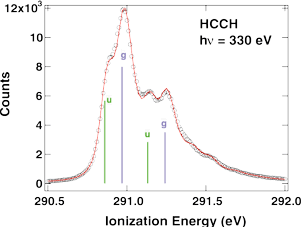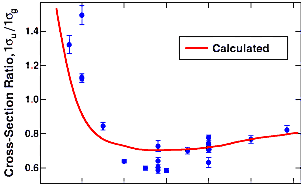
Symmetry Resolution Yields Evidence for Shape Resonance
The identification of elusive spectroscopic features known as shape resonances, once touted as a tool for measuring molecular bond lengths (see "Significance of a Resonance"), has over the years proven to be controversial. Now, the first convincing evidence for the existence of a shape resonance in acetylene has been obtained at the ALS through high-resolution photoelectron spectroscopy, where small splittings in molecular energy levels can be resolved.
 Measurements taken at the ALS are resolved into contributions from electrons of g (symmetric) and u (antisymmetric) character, as shown above. According to dipole selection rules, transitions to the shape resonance can result only from ionization involving electrons of g character ("1sigmag" ionization). Thus, the observation of enhanced 1sigmag ionization (i.e., larger 1sigmag cross section) at the predicted energy would provide strong support for the existence of a shape resonance. A plot of 1sigmau/1sigmag vs. photon energy (below) shows a minimum (i.e., 1sigmag is at a maximum) at about 317 eV, which coincides with the location of the shape resonance indicated by previous investigations and is slightly higher than predicted by theory. This result clearly demonstrates how the improvements in spectral resolution made possible by the ALS can help resolve outstanding questions in the scientific literature and lead to better understanding of the inner workings of molecules. |
Significance of a Resonance
|

Research conducted by T. D. Thomas, J. Hahne (Oregon State University); N. Berrah (Western Michigan University); E. Kukk (Western Michigan University and Berkeley Lab); J. Bozek (Berkeley Lab); T. X. Carroll (Keuka College); T. Karlsen and L. J. Saethre (University of Bergen, Norway), using Beamline 10.0.1 (formerly Beamline 9.0.1). Funding: U. S. Department of Energy, Office of Basic Energy Sciences; National Science Foundation; Research Council of Norway. Publication about this experiment: T. D. Thomas et al., Phys. Rev. Lett. 82, 1120 (1999). ALSNews article about this science highlight |
|
More ALS Science